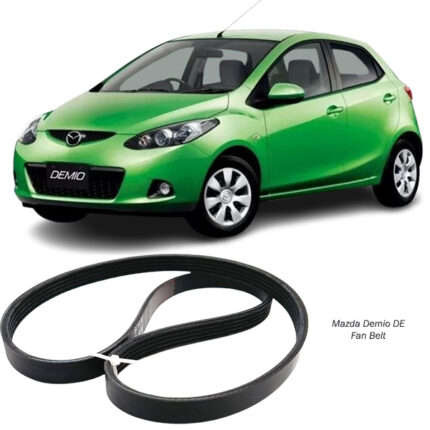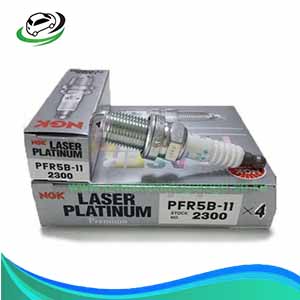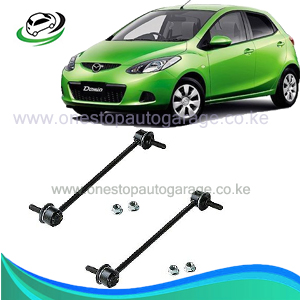-10%
Front Stabilizer Link Mazda Demio DE in Kenya
Find the best price for Mazda Demio DE Front Stabilizer Links in Nairobi Kenya.
In the intricate ballet of a vehicle’s suspension system, stabilizer links, also known as sway bar links, are unsung heroes that play a critical role in enhancing stability, steering control, and overall handling. These seemingly small components connect the sway bar to the suspension components and contribute significantly to a vehicle’s performance during turns and maneuvers. This comprehensive guide will explore the importance of stabilizer links in a vehicle’s suspension and illuminate the signs that indicate they may be worn out, requiring attention for continued safety and optimal handling.
Importance of Stabilizer Links in Vehicle Suspension:
- Enhanced Stability: Stabilizer links are integral components of a vehicle’s sway bar system. The sway bar, also known as an anti-roll bar, is designed to reduce body roll during cornering. Stabilizer links connect the ends of the sway bar to the suspension components, allowing the bar to transfer forces more effectively. This results in enhanced stability during turns, minimizing body sway and improving overall control.
- Improved Steering Response: Stabilizer links contribute to improved steering response and handling characteristics. By reducing body roll, these links help maintain consistent tire contact with the road surface during turns. This enhances steering precision, allowing the driver to navigate corners more effectively and respond to changes in direction with greater control.
- Balanced Weight Distribution: During cornering or sudden maneuvers, weight shifts within the vehicle. Stabilizer links aid in balancing this weight distribution by connecting the sway bar to the suspension. This ensures that the load is evenly distributed across the tires, promoting optimal traction and preventing excessive weight transfer that could compromise handling.
- Minimized Body Roll: Body roll, or the tilting motion of a vehicle during turns, is reduced by the action of stabilizer links. As the sway bar resists lateral forces generated during cornering, stabilizer links play a crucial role in keeping the vehicle level. This not only enhances handling but also contributes to a more comfortable and controlled ride for passengers.
Signs of Worn-Out Stabilizer Links:
- Clunking or Rattling Noises: One of the primary indicators of worn-out stabilizer links is the presence of clunking or rattling noises, especially when driving over bumps or during turns. Worn or damaged links may allow excessive movement in the sway bar, resulting in audible sounds. Addressing these noises promptly is crucial to prevent further damage to the stabilizer links and other suspension components.
- Increased Body Roll: As stabilizer links wear out, they become less effective in resisting body roll. If you notice increased body sway or a feeling of instability during turns, it may indicate that the stabilizer links are no longer providing sufficient support. Prompt inspection and replacement are essential to restore optimal handling and stability.
- Uneven Tire Wear: Worn stabilizer links can contribute to uneven tire wear. When the suspension system is compromised, it may lead to misalignment, causing tires to wear unevenly. Regularly inspecting your tires for signs of uneven tread wear patterns can help identify potential issues with the stabilizer links and the overall suspension system.
- Steering Instability: Stabilizer links play a critical role in maintaining steering stability. If the links are worn or damaged, the vehicle may exhibit steering instability, making it more challenging to control during turns. Drivers may experience a vague or imprecise feel in the steering wheel, indicating the need for immediate attention.
- Visible Damage or Play: A visual inspection of the stabilizer links can reveal signs of wear or damage. If there is visible play or movement in the links when the suspension is compressed or extended, it may suggest that the stabilizer links are loose or worn. Additionally, inspecting the rubber bushings for tears or damage can provide insights into the condition of the stabilizer links.
- Leaking Grease: Some stabilizer links are equipped with grease-filled bushings to reduce friction and enhance longevity. If you notice leaking grease around the connection points of the stabilizer links, it may indicate a failure of the seals or damage to the links. This requires prompt attention to prevent further deterioration.
Conclusion:
Stabilizer links are essential components of a vehicle’s suspension system, contributing to stability, steering control, and overall handling. Recognizing the signs of worn-out stabilizer links is crucial for maintaining optimal vehicle performance and safety. Regular inspections, attentive listening for unusual noises, and addressing any identified issues promptly can extend the lifespan of stabilizer links and contribute to the overall health of a vehicle’s suspension. By staying vigilant and responsive to these signs, drivers can uphold the integrity of their stabilizer links, ensuring a smoother ride, responsive steering, and enhanced handling on every journey.



